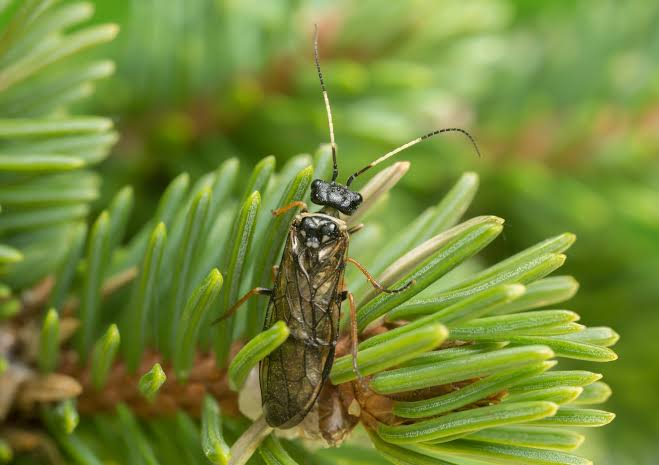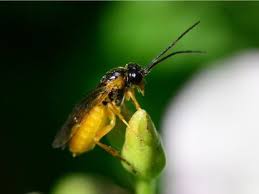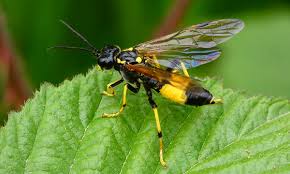Sawflies, scientifically known as Symphyta, are fascinating insects that belong to the suborder Symphyta within the order Hymenoptera. Unlike their close relatives, bees and ants, sawflies do not possess a constricted waist between the thorax and abdomen. These insects earned their common name from the saw-like ovipositor that females use to lay eggs on plants.
Sawflies exhibit a wide range of shapes, sizes, and colors, making them a diverse group. Despite their name, sawflies do not saw through wood, but rather, they are named for the saw-like structure on the female’s abdomen. This ovipositor is employed not for cutting, but for making small incisions in plant tissues where eggs are then deposited.
The life cycle of sawflies typically consists of four stages: egg, larva, pupa, and adult. The larval stage is particularly noteworthy, as sawfly larvae resemble caterpillars but can be distinguished by the presence of additional prolegs on their abdomens. These larvae often feed on plant foliage, displaying a voracious appetite that can lead to defoliation.
One interesting aspect of sawflies is their ability to form communal feeding groups during their larval stage. This behavior facilitates synchronized feeding and, in some cases, acts as a defense mechanism against predators. The larvae of certain sawfly species secrete substances that deter potential threats, providing a communal shield.
While sawflies are generally not considered pests on a large scale, certain species can cause significant damage to crops and ornamental plants. Integrated pest management strategies are often employed to control sawfly populations and minimize their impact on agriculture and horticulture.
In terms of ecological significance, sawflies play a role in pollination as they visit flowers in search of nectar. However, their primary ecological role lies in their interactions with plants, influencing the dynamics of plant populations and contributing to the overall balance of ecosystems.
In addition, sawflies, or Symphyta, offer a captivating glimpse into the world of insects. From their distinctive ovipositors to their diverse life cycles and communal behaviors, these creatures contribute to the intricate tapestry of nature. Understanding and appreciating the role of sawflies in ecosystems is crucial for maintaining ecological balance and sustainable agriculture.
Read Also: How to Grow, Use and Care for Wolftail Sedge Grass (Carex cherokeensis)
Plants Affected by Sawflies (Symphyta)

Sawflies can affect a variety of plants, causing damage through their feeding activities. These insects are known to target a range of trees, shrubs, and herbaceous plants. Some common plants affected by sawflies include roses, birch trees, pine trees, and certain fruit trees such as apple and cherry.
Sawfly larvae, in particular, are notorious for their voracious appetite, and they can quickly defoliate plants if their populations are not controlled. Roses, a popular ornamental plant, are often susceptible to sawfly larvae that feed on the leaves, leading to unsightly damage.
Birch trees, a favored host for certain sawfly species, may experience defoliation during an infestation. The larvae of birch sawflies feed on the leaves, and heavy infestations can weaken the tree and impact its overall health.
Pine sawflies are known to target various species of pine trees. The larvae of these sawflies consume pine needles, which can cause significant stress to the affected trees. Similarly, certain fruit trees like apple and cherry may face challenges from sawfly larvae feeding on their leaves.
While sawflies can pose a threat to these plants, it’s essential to note that the impact varies among different species and environmental conditions. Integrated pest management practices, including natural predators and appropriate insecticides, are often employed to mitigate the damage caused by sawflies and protect the health of affected plants.
Damages Caused by Sawflies

Sawflies can inflict various damages on plants, primarily through the feeding activities of their larvae. Some of the common damages caused by sawflies include defoliation, stunted growth, and, in severe cases, weakened plant health.
1. Defoliation: The most noticeable damage caused by sawflies is defoliation. Sawfly larvae are voracious feeders that consume the foliage of plants. As they chew through leaves, they can quickly strip a plant of its greenery, leaving it bare and vulnerable. This defoliation not only affects the plant’s aesthetics but can also impact its ability to photosynthesize and gather essential nutrients.
2. Stunted Growth: Continuous feeding by sawfly larvae can lead to stunted growth in affected plants. Deprived of the nutrients they need for healthy development, plants may struggle to grow at a normal rate. This can be especially problematic in agricultural settings where crop yields may be compromised.
3. Weakened Plant Health: Prolonged infestations of sawflies can weaken the overall health of plants. Reduced foliage and stunted growth make plants more susceptible to environmental stress, diseases, and other pests. Weakened plants are less resilient and may experience long-term consequences even after the sawfly infestation is controlled.
4. Impact on Fruit Production: Certain sawfly species that target fruit trees can have a detrimental impact on fruit production. The larvae may feed on leaves, reducing the tree’s ability to produce and ripen fruits. This can result in lower yields and affect the quality of the harvested fruits.
5. Secondary Issues: Besides direct feeding damage, sawflies can indirectly contribute to plant stress by creating wounds that may serve as entry points for pathogens. This can lead to secondary infections, further compromising the plant’s health.
Effective management of sawfly infestations involves monitoring populations, implementing control measures when necessary, and promoting overall plant health to enhance resilience against these insect pests. Integrated pest management approaches that consider both biological and chemical control methods are commonly employed to address the damages caused by sawflies.
Read Also: How to Grow, Use and Care for Wood Bluegrass (Poa nemoralis)
Control and Preventive Measures

Controlling and preventing sawfly infestations involves a combination of strategies to manage these insect pests effectively. Here are some key measures:
1. Natural Predators: Encourage natural predators of sawflies, such as parasitic wasps and predatory beetles, which can help keep sawfly populations in check. Creating habitats that support these beneficial insects contributes to a more balanced ecosystem.
2. Beneficial Microorganisms: Introduce beneficial microorganisms, like certain nematodes and fungi, that target sawfly larvae. These biological control agents can help reduce larval populations without harming beneficial insects.
3. Selective Pesticides: If necessary, use selective pesticides that specifically target sawflies while minimizing harm to beneficial insects. Careful consideration of the pesticide’s impact on the environment and non-target species is crucial.
4. Cultural Practices: Adopt cultural practices that discourage sawfly infestations. These may include rotating crops, maintaining proper spacing between plants, and practicing good garden hygiene by removing plant debris and fallen leaves where sawfly larvae might pupate.
5. Physical Barriers: Use physical barriers, such as floating row covers or mesh netting, to prevent adult sawflies from laying eggs on plants. This method is particularly useful in protecting susceptible crops from infestations.
6. Early Detection: Regularly inspect plants for early signs of sawfly infestation, such as chewed leaves or the presence of larvae. Early detection allows for prompt intervention and helps prevent the infestation from escalating.
7. Pruning Infested Branches: If sawfly larvae are concentrated in specific areas, consider pruning and removing infested branches. This can help contain the infestation and reduce the overall impact on the plant.
8. Plant Resistance: Choose sawfly-resistant plant varieties when possible. Some plant species have developed natural defenses against sawflies, making them less attractive to these pests.
9. Crop Rotation: In agricultural settings, practice crop rotation to disrupt the life cycle of sawflies. Moving susceptible plants to different locations from year to year can help reduce the likelihood of recurring infestations.
10. Educational Outreach: Educate gardeners, farmers, and the community about sawfly identification, life cycles, and control methods. Increasing awareness fosters proactive management and can prevent the spread of infestations.
Implementing a combination of these measures, tailored to the specific context and plant species involved, contributes to effective sawfly control and prevention while minimizing environmental impact.
Frequently Asked Questions (FAQs) About Sawflies (Symphyta)
Q1: What are sawflies?
A1: Sawflies are insects belonging to the suborder Symphyta within the order Hymenoptera. They are named for the saw-like ovipositor females use to lay eggs on plants.
Q2: What is the scientific name of sawflies?
A2: The scientific name for sawflies is Symphyta.
Q3: How do sawflies damage plants?
A3: Sawflies primarily damage plants through the feeding activities of their larvae. The larvae are voracious feeders that can cause defoliation, stunted growth, and weaken overall plant health.
Q4: What plants are commonly affected by sawflies?
A4: Sawflies can affect a variety of plants, including roses, birch trees, pine trees, and certain fruit trees like apple and cherry.
Q5: What is the life cycle of sawflies?
A5: The life cycle of sawflies typically includes four stages: egg, larva, pupa, and adult. Larvae are the most damaging stage as they feed on plant foliage.
Q6: How can I control sawfly infestations?
A6: Control measures include promoting natural predators, using beneficial microorganisms, employing selective pesticides, practicing cultural methods, using physical barriers, and early detection.
Q7: Are sawflies harmful to humans?
A7: No, sawflies are not harmful to humans. They do not sting or bite, and their main impact is on plants.
Q8: Can sawfly infestations be prevented?
A8: Yes, preventive measures include encouraging natural predators, selecting sawfly-resistant plant varieties, practicing good garden hygiene, and using physical barriers.
Q9: What are the signs of a sawfly infestation?
A9: Signs include chewed leaves, presence of sawfly larvae, and, in severe cases, defoliation of plants.
Q10: Can sawfly infestations be managed without using pesticides?
A10: Yes, integrated pest management approaches, incorporating natural predators, beneficial microorganisms, and cultural practices, can effectively manage sawfly infestations without relying solely on pesticides.
Read Also: How to Make an Avocado Tree Bear Fruit
